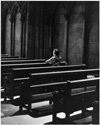The question came up as to when the Church started special Palm Sunday services. The Catholic Encyclopedia has this to say,
Liturgical writers differ in assigning a time for the introduction of the benediction of palms and of the procession. Martène, "De antiq. eccl. discipl." xx, 288, finds no mention of them before, the eighth or ninth century. Peliccia, "Christian. eccl. politia", II, 308, is of the same opinion and mentions Amularius, "De div. off.", I, x, as the first to speak of them. Binterim, V, i, 173, on the authority of Severus, Patriarch of Antioch, and of Josue Stylites, states that Peter Bishop of Edessa, about 397 ordered the benediction of the palms for all the churches of Mesopotamia. The ceremonies had their origin most probably in Jerusalem. In the "Peregrinatio Sylviæ", undertaken between 378 and 394, they are thus described: On the Lord's Day which begins the Paschal, or Great, Week, after all the customary exercises from cook-crow till morn had taken place in the Anastasia and at the Cross, they went to the greater church behind the Cross on Golgotha, called the Martyrium, and here the ordinary Sunday services were held. At the seventh hour (one o'clock p. m.) all proceeded to the Mount of Olives, Eleona, the cave in which Our Lord used to teach, and for two hours hymns, anthems, and lessons were recited. About the hour of None (three o'clock p. m.) all went, singing hymns, to the Imbomon, whence Our Lord ascended into heaven. Here two hours more were spent in devotional exercises, until about 5 o'clock, when the passage from the Gospel relating how the children carrying branches and Palms met the Lord, saying "Blessed is He that cometh in the Name of the Lord" is read. At these words all went back to the city, repeating "Blessed is He that cometh in the Name of the Lord." All the children bore branches of palm or olive. The faithful passed through the city to the Anastasia, and there recited Vespers. Then after a prayer in the church of the Holy Cross all returned to their homes.




Fr. Hunwicke points out that the tradition of processing with palms, calling out "Hosanna", goes back to the Jewish ceremony of Tabernacles. The 1st-century Jews in Jerusalem were simply adapting those rites and the psalms accompanying them ("Blessed is He who comes in the name of the Lord . . .") to the special circumstance of Jesus' entry on a humble beast of burden, as foretold by Zechariah (9:9).
ReplyDeleteIncidentally, the "Peregrinations of Sylvia" also supply early evidence for the original location of Herod's Temple as not having been on (what we now call) the Temple Mount, but below it, toward the old City of David.
Good to hear from you again Allan. I hope that all is well with you and your beloved. "Peregrination" was a new one on me. I think Aussies would call it a "walkabout".
ReplyDelete